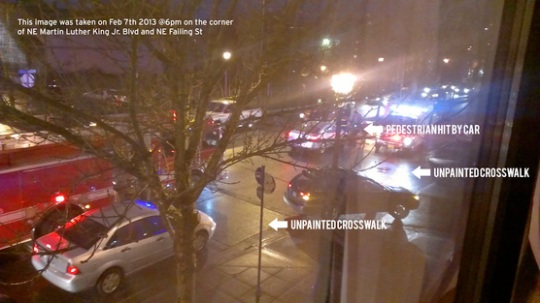“Demands for new biking, walking, transit, and other system improvements are common, but do you ever see activists clamoring for paving and street maintenance?”
Twice this week citizens of Portland have taken action to raise awareness about unsafe streets.
Benjamin Kerensa emailed us a video (watch it below) he put together of the crosswalk at NE 79th and Glisan. Kerensa witnessed a fatal collision last week involving a woman who was walking across that intersection in the sidewalk when she was hit by someone driving a car. The video, which shows numerous people failing to yield to people crossing the street, was featured on The Oregonian’s Hard Drive blog on Wednesday.
In his description of the video on YouTube, Kerensa pressured City Hall to improve the crosswalk:
“The City Council has been unresponsive in any attempt to address this matter both before the death of Heather Fitzsimmons and today. Also PBOT has been very difficult to work with telling us they do not have funding to improve the crosswalk…
I encourage those concerned about our lacking public infrastructure and traffic safety to please e-mail the Portland City Council and Portland Bureau of Transportation and demand they take action.”
Then today we learned about another bit of citizen activism regarding what someone perceives as an unsafe crossing of a major arterial. The Oregonian’s northeast Portland reporter Larry Bingham pointed us to an online petition by Portlander Christopher Herrick. Herrick works above the intersection of NE Failing and MLK Jr. Blvd., which he says is rife with dangers for those who attempt to cross.
He created this graphic to go along with his petition:

“From my office window I have witnessed dozens of accidents involving these crosswalks,” he wrote on Change.org, “and I’m tired of doing nothing while people are in danger of being hurt or killed, especially when all that’s necessary to stop it is a few lines of paint.”
These are just two examples of something that’s common in Portland: Citizens demanding action from City Hall for safer streets. As we’ve seen in coverage here over the years — and as I pointed out yesterday — our commission form of government where five commissioners (including the mayor) have equal power and one rules over each bureau, spending decisions often become highly politicized. In the transportation bureau, where a large portion of its budget is controlled by Council decisions, this phenomenon is especially strong. As a consequence, transportation spending decisions often reflect the whim of politicians and not always what’s fiscally and strategically prudent.
Demands for new biking, walking, transit, and other system improvements are common, but do you ever see activists clamoring for paving and street maintenance?
PBOT has come under fire from new Mayor Charlie Hales and from the City Auditor for, in their words, not spending enough on paving and maintenance. However, when citizen activists and advocacy groups are constantly beating the drum for system improvements rather than basic upkeep, it’s easy to see how a commissioner of transportation would bend toward the former (not to mention how crack-sealing and asphalt overlays are never on advocates’ project wish lists and rarely lead to ribbon-cuttings or photo-ops).
Put another way, street maintenance has never had an effective or consistent advocacy voice, while things like crossing improvements, sidewalks, new light-rail/streetcar projects, bikeways, and so on, have. Faced with online petitions and YouTube videos showing clear infrastructure needs, what’s a commissioner to do? Should they find money to remedy immediate safety concerns, or should they put that money into the vast abyss of the maintenance backlog where it will barely make dent?
As Mayor Hales looks over the transportation budget and decides where and how deep to swing his ax, that’s a question that will weigh heavily on his mind.


